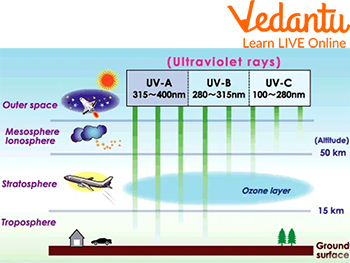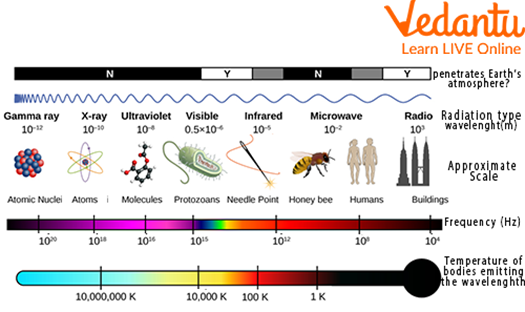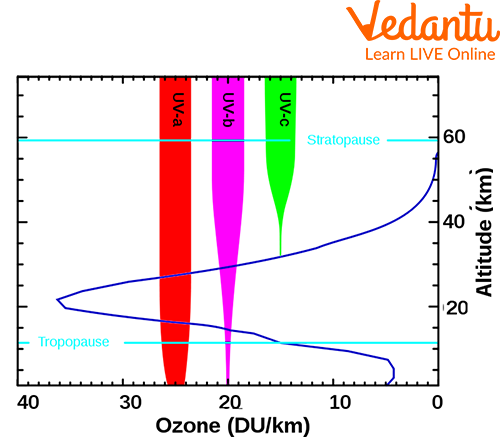




Ultraviolet Rays Definition
Ultraviolet rays are a type of electromagnetic radiation that has a wavelength shorter than visible light. They are invisible to human eyes, but they can be seen by cameras and other devices if they are given proper filters. Ultraviolet rays are the cause of sunburn and skin cancer.

Ultraviolet Rays
As we go out in the sun, ultraviolet rays penetrate our skin more deeply than visible light because their wavelengths are shorter. Because they have higher energy levels, ultraviolet rays can damage the DNA in cells more easily than visible light, which is less energetic and cannot penetrate as deeply into the skin.
What are Ultraviolet Rays?

Electromagnetic Waves of Various Rays
Ultraviolet rays are electromagnetic waves that have a wavelength shorter than visible light but longer than X-rays. Ultraviolet rays are invisible to the human eye but can be seen by animals with sensitive eyes, such as cats, dogs, and some birds.
Ultraviolet rays are a type of electromagnetic radiation. Ultraviolet rays are not visible to the naked eye because they are shorter than violet light. It is a type of ionizing radiation and it has properties that can damage cells and cause cancer.

UV rays classification as A,B,C
Classification of Ultraviolet Rays
Ultraviolet rays are classified as UVA, UVB, or UVC based on their wavelengths.
UVA
These waves have a wavelength ranging from 315 to 399 nm. The rays are not absorbed by the ozone layer.
UVB
These rays have a wavelength ranging from 280 to 314 nm. Part of these rays does reach the Earth's surface but is primarily absorbed by the ozone layer
UVC
These waves have a wavelength ranging from 100 to 279 nm. These types of ultraviolet rays are completely absorbed by the atmosphere and ozone layer
Uses of Ultraviolet Rays
The uses of ultraviolet Rays are as follows:
UV rays are used in tanning booths where our body is exposed to UV radiation, and our body produces melanin, making our skin darker. Tanning booths use artificial UV light in lamps which are used to tan the skin.
UV rays are used to analyze the chemical structure of a compound via colour changes. A machine is called a spectrophotometer, a machine which is used to analyze a compound's chemical structure through the change in colour. This is often used in water laboratories, biological plants and in the petrochemical industry.
UV rays are also used to produce polyphenols, which are a plant that is said to be helpful in the prevention of cancer. Patients are given a drug called psoralens, which reacts to UVA light treatment.
UV rays are also used in medicinal treatment, that is treating cancer. They are helpful in killing the tumour cells in the human body.
Application of UV Rays
UV rays are used to detect fake currency notes. Currency notes are exposed to UV radiations and the authentic UV marks are verified through the radiations.
UV radiation, also called black light, is used to photograph fingerprints. UV rays with the help of fluorescent powders or solutions are used as a spray or immersion to find fingerprints.
UV rays are also used to kill harmful bacteria from the water with the help of water purifiers.
Examples of Ultraviolet Rays
Some examples of ultraviolet rays are:
The sun’s ultraviolet waves produce the ozone layer in the atmosphere by reacting with oxygen and nitrogen gases.
UVB waves can cause sunburns and skin cancer if they reach the skin directly, or indirectly through water or snow.
UV light can cause skin cancer, cataracts and sunburns. It also damages DNA in cells and can lead to premature ageing or skin wrinkling.
UV radiation from sunlight is blocked by window glass, so people cannot get sunburned through their windows.
Applications of Ultraviolet Rays in the Medical Field
Some of the applications of ultraviolet rays include:
Ultraviolet rays can be dangerous but they can also be used in the medical field to treat skin conditions such as psoriasis, vitiligo and eczema.
Ultraviolet rays have been used in the medical field for a while now, but they are still not used as much as they should be.
Some of the most popular uses of ultraviolet rays in the medical field are:
Sunburns
Acne treatment
Psoriasis treatment
Treating skin cancer
Treating vitiligo
Ultraviolet rays have many applications in the medical field. It is used for sterilising, disinfecting, and killing bacteria and viruses in a person's body. It is also used to treat skin conditions like acne, eczema, psoriasis and vitiligo.
Summary
In this article, we have learned that UV rays are electromagnetic waves with a wavelength shorter than visible light. The sun emits UV rays that can cause skin cancer and eye damage. The first thing to note is that the sun emits ultraviolet rays, which are classified as electromagnetic waves with wavelengths shorter than visible light.
We also learned that these waves can cause skin cancer and eye damage because they have the potential to penetrate deep into the tissues of your skin and eyes. We read about UV rays in this article. We discussed its applications and uses in detail. We hope you enjoyed reading this article, in case of any other doubts, feel free to ask in the comments.
FAQs on Uses of Ultraviolet Rays
1. What are the most common uses of ultraviolet (UV) rays in daily life and industry?
Ultraviolet (UV) rays have a wide range of applications. Some of the most important uses include:
- Water Purification: UV lamps are used in water purifiers to kill harmful microorganisms like bacteria and viruses.
- Medical Applications: They are used for sterilising surgical instruments and in phototherapy to treat skin conditions like psoriasis and jaundice in newborns.
- Forensic Science: UV light is used at crime scenes to detect bodily fluids, forged documents, and counterfeit currency.
- Industrial Curing: UV radiation is used to instantly cure or dry inks, coatings, and adhesives in manufacturing processes.
- Pest Control: Bug zappers use UV light to attract insects.
2. How are UV rays used for sterilisation in hospitals and laboratories?
UV rays, specifically the UVC type, are used for sterilisation through a process called Ultraviolet Germicidal Irradiation (UVGI). UVC light has a short wavelength and high energy, which allows it to penetrate the cells of microorganisms like bacteria, viruses, and fungi. This energy damages their DNA and RNA, preventing them from reproducing and rendering them harmless. This method is used to sterilise surgical equipment, air in operating rooms, and laboratory surfaces without using harsh chemicals.
3. What is the importance of UV rays for human health?
While overexposure is harmful, a moderate amount of UV radiation, specifically UVB from the sun, is essential for human health. When UVB rays strike the skin, they trigger the production of Vitamin D. This vitamin is crucial for the body to absorb calcium and phosphorus, which are vital for developing and maintaining strong, healthy bones and supporting the immune system.
4. How do the different types of UV rays (UVA, UVB, UVC) differ in their applications?
The applications of UV rays depend on their specific type, which is determined by their wavelength:
- UVA (Long-wavelength): This is the least energetic type. It is primarily used in tanning beds, bug zappers, and for causing fluorescence, which helps in detecting counterfeit notes and in forensic investigations.
- UVB (Medium-wavelength): This type has more energy than UVA. Its primary biological importance is stimulating Vitamin D production in the skin. It's also used in phototherapy for treating certain skin diseases.
- UVC (Short-wavelength): This is the most energetic and damaging type. It is a powerful germicide and is almost exclusively used for sterilisation and disinfection of water, air, and surfaces because it effectively destroys microorganisms.
5. What are the primary harmful effects of overexposure to ultraviolet radiation?
Overexposure to UV radiation, particularly from the sun, can have several harmful effects on the human body. The most common negative impacts include:
- Sunburn: An inflammatory reaction of the skin caused by UVB radiation.
- Premature Aging: UVA rays can penetrate deep into the skin, leading to wrinkles and loss of elasticity (photoaging).
- Skin Cancer: Prolonged and cumulative exposure to UV radiation is a primary cause of various types of skin cancer, including melanoma.
- Eye Damage: UV rays can damage the cornea and lens, leading to conditions like cataracts and pterygium.
6. Why are UV rays effective in detecting forged documents and counterfeit currency?
UV rays are effective in this application due to a property called fluorescence. Many genuine currencies and official documents are printed with special inks that are invisible under normal light but glow or fluoresce when exposed to UV light. Forgers often use standard paper and ink that do not have these fluorescent markers. When a UV lamp is shone on a document, the genuine security fibres or markings will glow, while a counterfeit version will not, making forgery easy to detect.
7. How do UV water purifiers work to make water safe for drinking?
UV water purifiers work by passing water through a chamber containing a UVC lamp. The lamp emits short-wavelength ultraviolet radiation (at 254 nm), which is a powerful germicide. As water flows past the lamp, the UVC rays penetrate the cells of bacteria, viruses, and other pathogens. This radiation disrupts their genetic material (DNA and RNA), destroying their ability to multiply and cause disease. This process is a physical method of disinfection and does not use any chemicals, thus not altering the taste or odour of the water.









